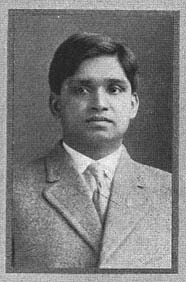Taraknath Das
|
|
|
"The Tyee: the Book of the Class of |
Taraknath Das was born in Bengal in 1884 into a middle-class family. While attending college in Calcutta, he was recruited into an anti-British secret society. By 1905, he had given up his studies and was wandering around India disguised as a mendicant student and spreading the revolutionary message. Wanted by police, he fled to Japan in 1905 disguised as a sadhu, or Hindu ascetic. After the British ambassador requested his extradition, Das fled to the U.S. in search of asylum. He arrived in Seattle in July, 1906.
Das enrolled in the University of California, Berkeley, and immediately set to work organizing Indian immigrants. Needing money to support his studies and activist politics, Das secured employment by the U.S. Immigration and Naturalization Service (INS) as an interpreter. He was posted to Vancouver, B.C., where his job was to ensure that no disembarking East Indians entered the U.S. His sympathies with his countrymen led him to surreptitiously coach immigrants in passing Canadian and U.S. agents’ interrogation.
Continuing his political activities among the Sikh population of British Columbia, Das started in 1908 a monthly magazine called Free Hindusthan1 to condemn policies of the British Indian government and encourage resistance. When the INS demanded he quit publishing the magazine or resign, he chose the latter.
Das stayed in Canada and started a school for Indian immigrants, teaching them English and nationalism. All the while he was under surveillance by British and Canadian authorities, who clamped down with an embargo on Free Hindusthan. Das moved to Seattle, and the magazine moved with him. He next enrolled in the Norwich Military Academy in Vermont with the presumptive goal of aiding his revolutionary objective. He attended for the 1908-09 academic year, but bowing to British diplomatic pressure, academy authorities did not let him graduate, instead giving him an honorable discharge.
Returning to Seattle, Das enrolled at the University of Washington, where he completed a B.A. in political science. At some point he came into contact with the well-connected Seattle lawyer, Edward Holton James, who was sympathetic to the Indian cause and provided money and advice. Awarded the UW’s first graduate fellowship in political science to conduct independent research on employers’ liability law in the U.W., Das obtained an M.A. and teaching certificate in 1911.
A man of seemingly limitless energy, Das was active in campus life, even as he continued his propaganda work on behalf of Indian independence. He served as president of the UW’s Cosmopolitan Club, whose membership included one of his professors, Edmond Meany of the Department of History. The historian served as a reference in his efforts to secure naturalization as a U.S. citizen, and also aided him in later plans to mount a World Students’ Congress in San Francisco in conjunction with the 1915 Pan-Pacific International Exposition in San Francisco. Das was also instrumental in founding the Hindusthan Association of America, a non-political organization intended to support Indian students in the U.S. Its journal,The Hindusthanee Student, documented the activities of Indian students, gave advice regarding higher education and employment opportunities, and provided a digest of relevant news and opinion.
After graduating from the UW, Das went to Berkeley, where he enrolled in a doctoral program but never finished. Instead, he continued his revolutionary organization and associated with Har Dayal of the Gadar party. In 1914, after several unsuccessful applications, he became a U.S.citizen. Now out of reach of the British government, he traveled to Germany on the eve of World War I and became involved in securing funds for an armed insurrection in India. Das took part in an unsuccessful German-Indian mission to destroy British-controlled railway along the Suez Canal and also traveled to China and Japan to organize the Pan-Asiatic League and promote India’s independence. In 1917 Das returned to the USA to face the charge of conspiring to violate the Neutrality Act. He and other conspirators were convicted in the Hindu-German Conspiracy case in San Francisco and Das was sentenced to 22 months in the penitentiary in Leavenworth, Kansas.
In 1923, Das and other naturalized citizens from India were disenfranchised when the Supreme Court ruled they were not “white”, voiding all previously granted citizenship. Two years later Das received the first Ph.D. from the School of Foreign Service in Georgetown University. Abandoning his earlier revolutionary stance, Das spent the rest of his years teaching in the U.S. and Europe. He and his wife, Mary Keatinge Morse, a founding member of the National Association for the Advancement of Colored People and the National Woman’s Party , established the Taraknath Das Foundation in 1935 to promote educational and cultural activities between nations. Eleven years later, in 1946, Das saw his citizenship restored when the U.S. once again permitted Indian-born immigrants to be naturalized.
The joy occasioned by India’s independence in 1947 was considerably muted for Das on account of the resulting partition between the predominantly Hindu and Muslim territories of India and Pakistan. The exile finally returned to his motherland in 1952 and was greeted by large crowds and front-page newspaper coverage. Taraknath Das died in December, 1958 in New York.2
1. Free Hindusthan, April 1908, RG 7, Series G21, volume 200, part 2b, enclosure in McInnes to Oliver, 3 April 1908, microfilm reel T-1172, Library and Archives Canada.
2. The source of much of the information in this essay is Tapan K. Mukherjee, Taraknath Das: Life and Letters of a Revolutionary in Exile (Calcutta: National Council of Education, Bengal, Jadavpur University, 1998).
